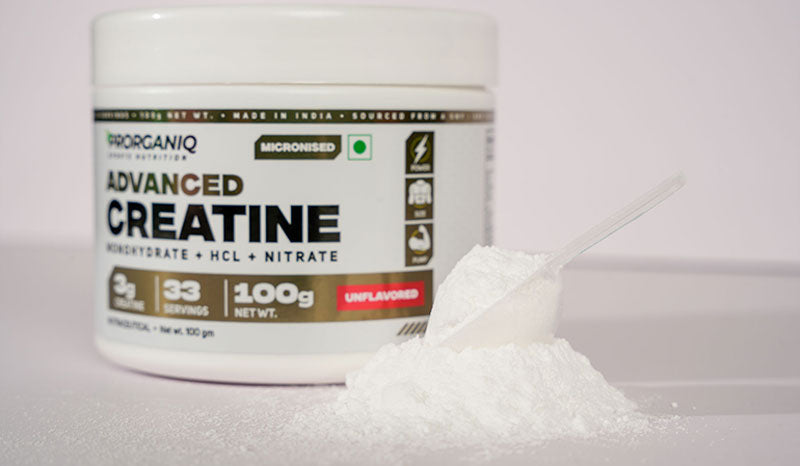Is Creatine a Protein? The Truth Explained!
Creatine - If you've stepped into the world of fitness and nutrition in India, you have likely encountered the word "creatine" more than once.
It’s a supplement that’s widely popular among gym-goers, athletes, and bodybuilders. But one question that pops up frequently among beginners is: Is creatine a protein?
The confusion is understandable, given that both protein and creatine play roles in muscle development.
However, they are fundamentally different in structure, function, and purpose.
Is Creatine a Protein?
No, creatine is not a protein. It’s a compound that boosts energy during intense workouts, while protein helps build and repair muscle tissue.
✔ No, creatine is not a protein.
✔ Protein is a macronutrient made of amino acids, essential for muscle repair and growth.
✔ Creatine is a compound formed from three amino acids: arginine, glycine, and methionine.
✔ It helps regenerate ATP, the primary energy source for muscle contractions during high-intensity workouts.
✔ Unlike protein, creatine doesn’t directly build muscle but enhances performance and strength by fueling short bursts of activity.
✔ It’s found in small amounts in red meat and fish, and can be supplemented, especially useful for vegetarians.
✔ Both protein and creatine serve different but complementary roles in fitness and muscle development.
Creatine vs. Protein
To clarify the confusion, let’s start with basic definitions.
Protein is one of the three macronutrients (along with carbohydrates and fats) that our body requires for various functions.
It is made up of amino acids, which are the building blocks of muscles, skin, enzymes, and hormones.
For anyone involved in strength training or muscle building, protein intake is crucial to repair and build muscle tissue.
Creatine, on the other hand, is not a macronutrient. It is a naturally occurring compound found in small amounts in foods like red meat and fish. It's also produced by the liver, kidneys, and pancreas.
Creatine is made up of three amino acids: arginine, glycine, and methionine. However, unlike protein, its primary function is not to build muscle tissue directly.
Instead, it helps regenerate ATP (adenosine triphosphate), the primary energy currency of cells, which powers short bursts of high-intensity activity like weightlifting or sprinting.
Can Creatine and Protein Be Taken Together?
Absolutely. Combining creatine with protein supplementation is common among athletes and gym-goers.
Post-workout is typically the best time to consume both. While protein helps initiate muscle repair, creatine helps replenish the energy stores used during your training.
Many fitness professionals recommend mixing creatine powder with your whey protein shake after workouts for convenience and effectiveness.
For Indian consumers, this combo is also cost-effective and practical. Many Indian brands now offer combo packs or formulas that blend creatine with protein for post-workout use.
It’s worth noting that creatine is best taken consistently, even on non-workout days, to maintain muscle saturation.
There’s no need for a loading phase, although some people choose to do it for quicker results.
Myths About Creatine in the Indian Context
Let’s address some common myths surrounding creatine in India:
✔️ Myth 1: Creatine is a steroid
This is a major misconception. Creatine is a legal, natural compound found in the body and food.
Steroids are synthetic substances that mimic testosterone and can have severe side effects. Creatine, on the other hand, is one of the most researched and safest supplements available.
✔️ Myth 2: Creatine damages the kidneys
This concern often arises in Indian households where traditional wisdom influences dietary choices.
Research has shown that creatine is safe for healthy individuals when taken in recommended doses.
✔️ Myth 3: Creatine causes water retention and bloating
While it’s true that creatine can cause your muscles to hold water, this is intracellular water that makes your muscles look fuller and more pumped, not bloated.
✔️ Myth 4: You need to cycle creatine
There’s no scientific basis for cycling creatine. Continuous usage (3–5 grams per day) is safe and effective.
Should You Take Creatine? A Guide for Indian Fitness Aspirants
So, should you add creatine to your routine? Here’s a guide to help you decide:
✅ You’re a vegetarian or vegan: Since dietary sources of creatine are limited, supplementation can significantly enhance performance and energy.
✅ You’re into strength training or high-intensity sports: Creatine can help you lift more, train harder, and recover quicker.
✅ You’re looking for safe, effective performance enhancement: Creatine is backed by hundreds of studies and is considered safe for long-term use.
✅ You have no existing kidney issues: If you’re healthy, creatine is very safe. Just stay within the 3–5g daily dose.
How to take creatine?
Opt for Creatine Monohydrate, the most researched and affordable form.
Take 3–5 grams daily, preferably post-workout with water or a protein shake.
Stay hydrated to avoid cramping or digestive discomfort.
Popular Indian supplement brands now offer high-quality creatine products that are budget-friendly and lab-tested.
Brands like BigMuscles, MuscleBlaze, and AS-IT-IS Nutrition have gained popularity for providing creatine monohydrate that meets international standards.
Final Thoughts
To answer the original question, no, creatine is not a protein.
It’s a performance-enhancing compound that complements your workout routine by improving energy production, allowing you to train harder and more effectively.
While protein builds and repairs muscles, creatine gives you the energy to push your limits.
For Indian fitness enthusiasts navigating traditional diets, busy schedules, and unique nutritional needs, creatine can be a game-changing addition to their supplementation stack.
Just remember, supplements are just that: supplements. They should never replace a balanced diet, consistent training, and proper recovery.
But when used wisely, creatine can help elevate your fitness journey to the next level.


